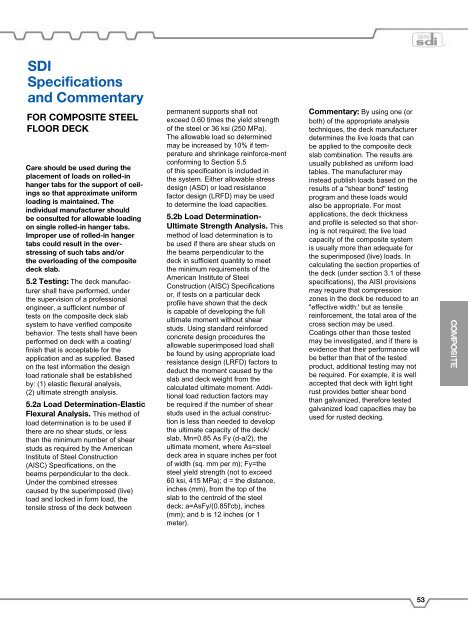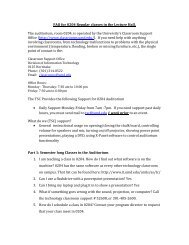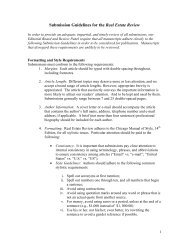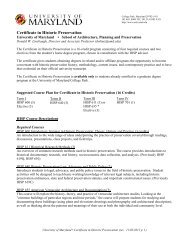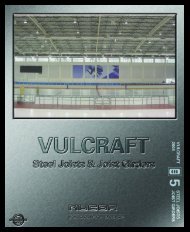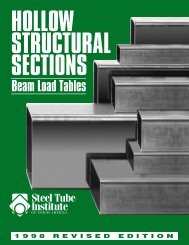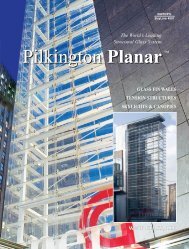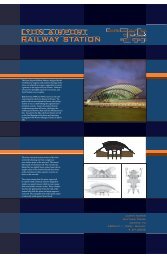Vulcraft Steel Roof and Floor Deck Catalog - University of Maryland ...
Vulcraft Steel Roof and Floor Deck Catalog - University of Maryland ...
Vulcraft Steel Roof and Floor Deck Catalog - University of Maryland ...
- No tags were found...
You also want an ePaper? Increase the reach of your titles
YUMPU automatically turns print PDFs into web optimized ePapers that Google loves.
SDI<br />
Specifications<br />
<strong>and</strong> Commentary<br />
FOR COMPOSITE STEEL<br />
FLOOR DECK<br />
Care should be used during the<br />
placement <strong>of</strong> loads on rolled-in<br />
hanger tabs for the support <strong>of</strong> ceilings<br />
so that approximate uniform<br />
loading is maintained. The<br />
individual manufacturer should<br />
be consulted for allowable loading<br />
on single rolled-in hanger tabs.<br />
Improper use <strong>of</strong> rolled-in hanger<br />
tabs could result in the overstressing<br />
<strong>of</strong> such tabs <strong>and</strong>/or<br />
the overloading <strong>of</strong> the composite<br />
deck slab.<br />
5.2 Testing: The deck manufacturer<br />
shall have performed, under<br />
the supervision <strong>of</strong> a pr<strong>of</strong>essional<br />
engineer, a sufficient number <strong>of</strong><br />
tests on the composite deck slab<br />
system to have verified composite<br />
behavior. The tests shall have been<br />
performed on deck with a coating/<br />
finish that is acceptable for the<br />
application <strong>and</strong> as supplied. Based<br />
on the test information the design<br />
load rationale shall be established<br />
by: (1) elastic flexural analysis,<br />
(2) ultimate strength analysis.<br />
5.2a Load Determination-Elastic<br />
Flexural Analysis. This method <strong>of</strong><br />
load determination is to be used if<br />
there are no shear studs, or less<br />
than the minimum number <strong>of</strong> shear<br />
studs as required by the American<br />
Institute <strong>of</strong> <strong>Steel</strong> Construction<br />
(AISC) Specifications, on the<br />
beams perpendicular to the deck.<br />
Under the combined stresses<br />
caused by the superimposed (live)<br />
load <strong>and</strong> locked in form load, the<br />
tensile stress <strong>of</strong> the deck between<br />
permanent supports shall not<br />
exceed 0.60 times the yield strength<br />
<strong>of</strong> the steel or 36 ksi (250 MPa).<br />
The allowable load so determined<br />
may be increased by 10% if temperature<br />
<strong>and</strong> shrinkage reinforce-ment<br />
conforming to Section 5.5<br />
<strong>of</strong> this specification is included in<br />
the system. Either allowable stress<br />
design (ASD) or load resistance<br />
factor design (LRFD) may be used<br />
to determine the load capacities.<br />
5.2b Load Determination-<br />
Ultimate Strength Analysis. This<br />
method <strong>of</strong> load determination is to<br />
be used if there are shear studs on<br />
the beams perpendicular to the<br />
deck in sufficient quantity to meet<br />
the minimum requirements <strong>of</strong> the<br />
American Institute <strong>of</strong> <strong>Steel</strong><br />
Construction (AISC) Specifications<br />
or, if tests on a particular deck<br />
pr<strong>of</strong>ile have shown that the deck<br />
is capable <strong>of</strong> developing the full<br />
ultimate moment without shear<br />
studs. Using st<strong>and</strong>ard reinforced<br />
concrete design procedures the<br />
allowable superimposed load shall<br />
be found by using appropriate load<br />
resistance design (LRFD) factors to<br />
deduct the moment caused by the<br />
slab <strong>and</strong> deck weight from the<br />
calculated ultimate moment. Additional<br />
load reduction factors may<br />
be required if the number <strong>of</strong> shear<br />
studs used in the actual construction<br />
is less than needed to develop<br />
the ultimate capacity <strong>of</strong> the deck/<br />
slab. Mn=0.85 As Fy (d-a/2), the<br />
ultimate moment, where As=steel<br />
deck area in square inches per foot<br />
<strong>of</strong> width (sq. mm per m); Fy=the<br />
steel yield strength (not to exceed<br />
60 ksi, 415 MPa); d = the distance,<br />
inches (mm), from the top <strong>of</strong> the<br />
slab to the centroid <strong>of</strong> the steel<br />
deck; a=AsFy/(0.85f'cb), inches<br />
(mm); <strong>and</strong> b is 12 inches (or 1<br />
meter).<br />
Commentary: By using one (or<br />
both) <strong>of</strong> the appropriate analysis<br />
techniques, the deck manufacturer<br />
determines the live loads that can<br />
be applied to the composite deck<br />
slab combination. The results are<br />
usually published as uniform load<br />
tables. The manufacturer may<br />
instead publish loads based on the<br />
results <strong>of</strong> a "shear bond" testing<br />
program <strong>and</strong> these loads would<br />
also be appropriate. For most<br />
applications, the deck thickness<br />
<strong>and</strong> pr<strong>of</strong>ile is selected so that shoring<br />
is not required; the live load<br />
capacity <strong>of</strong> the composite system<br />
is usually more than adequate for<br />
the superimposed (live) loads. In<br />
calculating the section properties <strong>of</strong><br />
the deck (under section 3.1 <strong>of</strong> these<br />
specifications), the AISI provisions<br />
may require that compression<br />
zones in the deck be reduced to an<br />
"effective width:' but as tensile<br />
reinforcement, the total area <strong>of</strong> the<br />
cross section may be used.<br />
Coatings other than those tested<br />
may be investigated, <strong>and</strong> if there is<br />
evidence that their performance will<br />
be better than that <strong>of</strong> the tested<br />
product, additional testing may not<br />
be required. For example, it is well<br />
accepted that deck with light tight<br />
rust provides better shear bond<br />
than galvanized, therefore tested<br />
galvanized load capacities may be<br />
used for rusted decking.<br />
53


